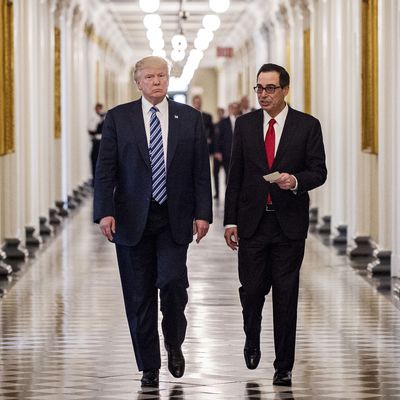
Nearly 100 days into his presidency — and 22 months after launching his campaign for the Oval Office — Donald Trump is finally, almost ready to unveil his “principles” for tax policy. On Tuesday, Treasury Secretary Steve Mnuchin and National Economic Council Director Gary Cohn will meet with congressional leaders to iron out the finer details of the president’s broad-strokes blueprint. On Wednesday, that blueprint will go public.
It’s easy to mock the GOP for still being huddled around the tax-plan drawing board. After all, Trump released multiple tax plans over the course of the 2016 campaign, while Paul Ryan and friends have been touting their own supply-side visions for years.
Still, any fair-minded observer has to concede: Regressive tax reform ain’t easy. Formulating a politically tenable way of cutting taxes on wealthy individuals and corporations — without significantly expanding the deficit — is an immense challenge. There are very few policy ideas more unpopular than lessening the tax burden of rich people; except, perhaps, for raising them on middle-income households. And to “reform” the corporate tax code in a revenue-neutral way necessarily requires overcoming the opposition of one well-heeled interest group or another — a fact of which the House’s border-adjustment tax enthusiasts are painfully aware.
So, given what a gnarly beast tax reform is, it’s understandable that it’s taken the president a while to find his silver bullet. And now, after months of careful deliberation, Trump has finally arrived at an intricate, nuanced plan for balancing the GOP’s political and ideological imperatives on tax rates: Cut taxes big league, and don’t worry about paying for ’em.
As The Wall Street Journal reports:
President Donald Trump has ordered White House aides to accelerate efforts to draft a tax plan slashing the corporate rate to 15% and prioritizing cuts in tax rates over an attempt to not increase the deficit, according to a person familiar with the directive. During a meeting inside the Oval Office last week, Mr. Trump told staff he wants a massive tax cut to sell to the American people, the person said. It was less important to him if the plan loses revenue. Mr. Trump told his team to “get it done,” in time to release a plan by Wednesday … There likely aren’t enough business tax breaks that could be repealed to offset the fiscal cost, meaning such a move would increase budget deficits. Roughly, each percentage-point cut in the tax rate lowers federal revenue by $100 billion over a decade, so a 20-point cut would cost the government $2 trillion, according to the congressional Joint Committee on Taxation.
Such an approach would make passing permanent tax cuts impossible. To evade a Democratic filibuster, Republicans must pass their regressive tax cuts through the “reconciliation” process. But reconciliation bills cannot increase the deficit outside of the first ten years after they’re passed. Which means Trump’s proposed tax cut would be saddled with an expiration date.
This is probably where the GOP’s plan was always bound to end up. Like George W. Bush before him, Trump will likely find it prohibitively difficult to pass deeply unpopular tax cuts for the rich, while also pushing through deeply unpopular spending cuts and/or middle-class tax increases. Far better to embrace supply-side voodoo and pretend that your gift to the one percent actually pays for itself — no matter how opulent that gift may be.






























